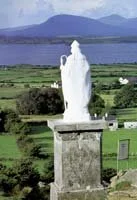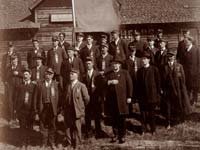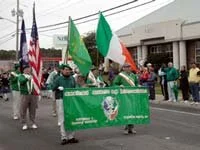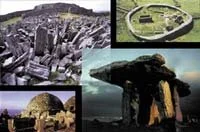The Protestant Reformation that swept Europe in the 16th century was marked by Royal intrigues over control of the Catholic Church’s wealth, and conflicts over which religion could be practiced. Violence erupted in many countries. Elizabeth I declared the Church of England the State religion, and considered Ireland part of her state. Most Irish did not agree.
The Catholic Church launched a counter-reformation and Ireland became a battlefield between the two forces as the Irish, who embraced the Church introduced by St. Patrick, became the target of a campaign to reduce Rome’s power by converting the masses to Protestantism. The persistence with which the Irish clung to their religion drove the English to extremes in repression.
Penal laws disenfranchised Irish Catholics from the political, social, and economic life of their own country, and with their religion outlawed and their clergy on the run, they became an underground society practicing their religion in secret.
Not surprisingly, secret societies were formed to protect the values under attack. In various locales, groups with names like Whiteboys, Ribbonmen, and Defenders were identified with attacks on landlords, but each society included in its avowed purpose the protection of the Catholic Church and its clergy. As time and government prevailed, some societies were suppressed, but most reorganized under a new name for the same purpose — defense of faith and homeland. History provides us with the names of many of these organizations, and even limited details of some. We know, for example, that the motto of the Defenders in 1565 was Friendship, Unity, and True Christian Charity, but the secret manner in which these societies operated left few records for modern analysts. As a result, a true history of their times may never be written.
What history does tell us however, is that continued oppression and periodic crop failures forced many Irish to flee to other lands for survival. The inclination toward secret societies which had developed in Ireland was by now an Irish defense mechanism, especially among those emigrants doomed to the ethnic slums of the lands to which they fled. Initially formed as fraternal societies to promote the welfare of its members, like the Hibernian Sick and Funeral Society in England, they soon found a militant dimension necessary to protect their church and clergy and defend members from bigoted opposition.
In early nineteenth century America, the Ancient Order of Hibernians with its motto Friendship, Unity, and Christian Charity became the most recent link in the evolution of those ancient societies. Organized with the same intention of defending Gaelic values under attack, it can claim continuity of purpose and motto unbroken back to the Defenders of 1565.
Colonial America was an extension of England in language, customs, and traditions and though American historians claim religious freedom back to William Penn’s Pennsylvania, John Locke’s Carolina, Roger Williams’s Rhode Island, and others, this freedom did not include Catholics. These were still English colonies and though they were willing to accept other Protestant sects, they discriminated against Catholics because of a biased belief that Catholics owed allegiance to a foreign prince – the Pope. By 1700, New York’s Catholic population was almost stamped out by drastic penal laws.
Then came the Revolution, and despite the large number of Catholics who supported Washington, the spirit of the leading colonists was still intensely anti-Catholic. The first banner raised by the Sons of Liberty in New York was inscribed “No Popery.” Not much changed after independence either. At the Constitutional Convention in 1777, a strong anti-Catholic faction was led by John Jay, soon to be first Chief Justice of the United States, who denied civil rights to Catholics until they swore an oath renouncing the authority of the Pope. Thereafter, Catholics were barred from public office unless they took the Test Oath. This was the America to which a steady flow of Irish Catholics emigrated after the failed rising of 1798 in Ireland.
As the Irish population grew, anti-Catholic forces celebrated Pope Day, and carried straw effigies of St. Patrick on March 17th which were desecrated to taunt the Irish. The new Irish were quick to defend their honor; their reaction was swift, and violence was a normal result. The influence of the growing Irish population finally forced the city to ban such effigies in 1802. Then in 1806, State Senator and city Mayor De Witt Clinton abolished the Test Oath. But some forces were not happy, and a few months later, an anti-Catholic mob attacked St. Peters Church. They were held off by members of the Irish community who formed a guard around the building, but the confrontation sparked two days of rioting.
Anti-Catholic bigotry, cloaked in the guise of American patriotism, emerged in a nativist prejudice against immigrants — especially the Irish, who began arriving in large numbers. A period of extreme intolerance was launched in the early 1800s that began with social segregation, resulted in discrimination in hiring, and reached its climax in the formation of such nativist gangs such as the Order of the Star Spangled Banner, the True Blue Americans, and others bent on violence against the Irish Catholic immigrant population.
These gangs would coalesce in 1854 into the American Party or Know Nothings. Reminiscent of the penal laws, they sought legislation against the immigrant population who, it was stated, diluted American principles. The growing number of destitute Irish, fleeing conditions in their native land, had become a focus of that prejudice. They were driven to the most difficult and demanding forms of labor where even minimal safety and welfare standards were ignored. In Ireland, the bias of their colonial masters made it necessary to guard their activities from public scrutiny; in America the prejudice from nativists and abusive employers made similar secrecy necessary. Gradually, they came together in the same type of secret societies that had protected them in Ireland.
Nativist prejudice grew from intolerance to violence. St. Mary’s Church in New York was burned to the ground in 1831; in 1832, 57 Irish railroad workers suffering from Cholera near Malvern, Pennsylvania were refused medical attention, died and were dumped in an unmarked mass grave; in 1834, the Ursuline Convent in Massachusetts was burned down; while in 1834 and 35, nativist gangs attacked the Irish neighborhood of Five Points in New York City resulting in several major street brawls that lasted for days.
Then, in 1836, according to The Miner’s Journal, a newspaper in Pennsylvania’s Schuykill County anthracite coalfield region, and other verified sources of information, we learned that a contingent of miners from a group called the Hibernian Benevolent Society traveled to New York’s St Patrick’s Day parade. While there, they met with a group of New York activists from the St. Patrick’s Fraternal Society.
The subject of the meeting is not recorded, but since nativist activity was becoming a national threat, it is not difficult to imagine the Irish seeking to coalesce several societies into one major defensive organization. Thus was born The Ancient Order of Hibernians (AOH). In several versions of the their own history, written and expanded over its lifetime, reference is made to the founding of its first Division at New York’s St James Church on May 4, 1836 — less than two months after the historic meeting of the New York and Pennsylvania activists. Coincidentally, another Division was formed at the same time in the coal-fields of Pennsylvania. Local tradition notes that one Jeremiah Reilly of Cass Township, Hecksherville, Schuylkill County, PA started the first AOH division there, but no records have been found to authenticate this.
Know Nothing activities spread across the country. In 1854, construction of the Washington Monument was halted when nativists stole and destroyed a granite block donated to the project by Pope Pius IX since they would tolerate no Catholic stone in that icon to America’s first president. The following year, a nativist attack on an Irish neighborhood in Louisville, KY caused 22 deaths and considerable arson and looting.
Although the secrecy surrounding the early operation of the AOH makes their origins and their reaction to such attacks difficult to define, it is not unlikely that those who had been members of secret societies in Ireland and England called on their collective experience, and banded together in this new land for the same or similar defensive purposes and dispensed home-grown justice. Soon, other societies like the Hibernian Friendship Society in Arlington Virginia, founded in 1831, joined the growing union of Irish societies that became known as the Ancient Order of Hibernians.
As nativist bigotry spread across America, so too did the AOH. True to their purpose, they provided social welfare benefits to members and stood guard to defend Church property. After their formation, actual attacks were few and far between, but the long, cold, and lonely nights of vigil were many. At about this time, a society in Ireland adopted the name Ancient Order of Hibernians and the organization now had Irish links.
As the heroism of the Irish Brigade and other Irish units in the American Civil War had America cheering for the exploits of the sons of Erin in American uniform, the honesty, devotion, and natural charm of the Irish girls, who had found employment as domestic help, were winning admirers on the home front. The natural result of this new regard was a decrease in prejudice against the Irish, and the Know Nothing movement, recognized for the bigoted group it was, faded away.
It would emerge again in organizations like the Ku Klux Klan, and other groups dedicated to ethnic hatred and anti-Catholic propaganda, but never again would America support a national army of zealots. The AOH, on the other hand, grew stronger. It followed Irish immigrants as they worked their way across the country.
The early AOH in America remained a defensive, yet secret, society, and while little is known of its specific activities, it is known that it assisted Irish immigrants in obtaining jobs and social services. Membership was well-guarded and restricted to Irish-born. Even meeting minutes used member numbers instead of names to protect identities. The first national conventions of the Order were held in New York, but as the Order grew. Other jurisdictions began seeking the honor, with Boston becoming the site of the first non-NY gathering. Some controversial issues arose in the early Order including opening membership to Irish Americans so that American-born sons of immigrants could join and the right of the AOH in Ireland to speak for the Order when they were still dominated by the Crown. At the same time, the militant Fenian Brotherhood began to infiltrate the AOH and run their people for top AOH offices. In the midst of all these issues the AOH split!
There were now two organizations in America: one took the name of the AOH, Board of Erin, and the other the AOH in America. Politics, personality conflicts, and petty jealousy brought to a shameful state, one of the noblest of the ancient Orders of Ireland. It would be years before saner heads prevailed and the two factions in America were brought to true brotherhood. The sad part is that the American and Irish branches of this noble order were not officially reconciled. Years later, the apolitical and religious posture of the Irish organization dictated their support for Parnell’s struggle for an independent Ireland through Parliamentary reform and they became champions of Home Rule. The appearance in the early 1900’s of a more militant faction never swayed the AOH Board of Erin from that commitment, and they were often criticized for not being outspoken disciples of the revolutionary action proposed by the heroes of Easter Week.
They remained true to their principles, and gave neither support nor opposition to the militants during the 1916 insurrection, the War of Independence, and the Civil War that followed. This again strained relations with the American AOH who supported the militants although some AOH divisions in Ireland did take part in the rising. For years, the two Boards remained as distant cousins who never spoke. Few remembered, or even knew, the old animosities, and fewer still held grudges against the branch of the Order across blue highway home, yet the breach remained – in spite of the fact that the AOH in America proudly pointed to their Irish heritage and the fact that the Irish organization had a litany of proud accomplishments and opposition to the Crown.
Then, in 1981, Jack Connolly, President of the AOH in America, stopped into an AOH hall in Ireland. His historic gesture, opened dialogue between the two branches of the Order, and resulted in the visit of a group of Belfast Hibernians to Boston and New York to march in their St Patrick’s Day parades. Hospitality was provided to visiting Hibernian officials during the next few administrations, but little of significance occurred until 1992 when Board of Erin Secretary Frank Kieran visited America. Hibernian hospitality was extended by the American Board and, in conversations held during that visit, it was proposed that the two branches consider a joint project. At the 1994 American National Convention in Louisville Kentucky, it was announced that the joint project would be a memorial to the victims of the Great Hunger to be erected in Ireland in 1995.
On August 20 1995, the dream came true as the American and Irish National Boards gathered in Ennistymon, Co. Clare to dedicate that memorial. In unveiling the memorial, Dail Eireann’s Minister of State, Donal Carey, noted that this was the first national monument in all of Ireland to the victims of the Great Hunger, and it took the AOH to do it. It was a proud moment for the AOH, and a visible indication of what unity can achieve. More significant, but less publicized was an event that took place days earlier on August 12, just after the American Board had arrived in Ireland. It was the first joint meeting in history between the AOH National Boards of America, Ireland, England, Scotland, and Wales. That meeting opened a new chapter in Hibernian history, which was confirmed by the hospitality extended in Hibernian Halls in Counties Louth, Down, Antrim, and Derry where the American Board was hosted and celebrated. The American Order also marched in solidarity with Board of Erin AOH in Co. Derry in commemoration of the Feast of the Assumption and later, Bloody Sunday. As a result of those historic gatherings and marches, the prejudice of the past has been buried, and the AOH now stands, not only as the oldest Catholic Lay organization in America, but as the largest Irish Catholic society in the world with Divisions across the United States, and close ties with the AOH in Ireland, England, Scotland, and Wales, and most recently the AOH in Canada.
In America, the Division is the basic unit of the Order. Divisions are combined into County Boards, which are in turn governed by State Boards, and an overall National Board elected every two years. Annual dances, concerts, and parades sponsored at all levels of the Order raise millions for charity while providing a showcase for the positive contributions the Irish have made in every walk of American life. Divisions and Hibernian Halls across the country have traditionally provided a welcome for new immigrants. Here, the unique art, dance, music, and other interests of the Irish are fostered and preserved, making the AOH a home away from home for many. They are at the forefront of support for issues concerning the Irish such as Immigration Reform, MacBride Legislation, and the Right to Life. They serve their Church well, yet, they never forget their ancestral homeland, and can always be found lobbying, praying, and working for the total independence of a united 32-county Ireland — as their constitution avows: “by all means constitutional and lawful.”
The initials AOH may tell the story best. Those who say it means “Add One Hour” are describing the easygoing, no rush attitude of many of its members, while “America’s Only Hope” has been used to define the loyalty of the Irish to the principles of their adopted land. In any case, its members are best described by the statement, “To be Irish is a Blessing, To be a Hibernian is an Honor.”







